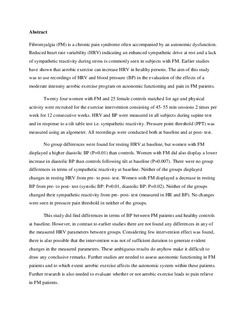| dc.contributor.author | Brandsarbakken, Håvard | nb_NO |
| dc.date.accessioned | 2014-12-19T14:44:22Z | |
| dc.date.available | 2014-12-19T14:44:22Z | |
| dc.date.created | 2010-11-18 | nb_NO |
| dc.date.issued | 2010 | nb_NO |
| dc.identifier | 370892 | nb_NO |
| dc.identifier.uri | http://hdl.handle.net/11250/271489 | |
| dc.description.abstract | Fibromyalgia (FM) is a chronic pain syndrome often accompanied by an autonomic dysfunction. Reduced heart rate variability (HRV) indicating an enhanced sympathetic drive at rest and a lack of sympathetic reactivity during stress is commonly seen in subjects with FM. Earlier studies have shown that aerobic exercise can increase HRV in healthy persons. The aim of this study was to use recordings of HRV and blood pressure (BP) in the evaluation of the effects of a moderate intensity aerobic exercise program on autonomic functioning and pain in FM patients.
Twenty four women with FM and 25 female controls matched for age and physical activity were recruited for the exercise intervention consisting of 45- 55 min sessions 2 times per week for 12 consecutive weeks. HRV and BP were measured in all subjects during supine rest and in response to a tilt table test i.e. sympathetic reactivity. Pressure point threshold (PPT) was measured using an algometer. All recordings were conducted both at baseline and at post- test.
No group differences were found for resting HRV at baseline, but women with FM displayed a higher diastolic BP (P=0.01) than controls. Women with FM did also display a lower increase in diastolic BP than controls following tilt at baseline (P=0.007). There were no group differences in terms of sympathetic reactivity at baseline. Neither of the groups displayed changes in resting HRV from pre- to post- test. Women with FM displayed a decrease in resting BP from pre- to post- test (systolic BP: P=0.01, diastolic BP: P=0.02). Neither of the groups changed their sympathetic reactivity from pre- post- test (measured in HR and BP). No changes were seen in pressure pain threshold in neither of the groups.
This study did find differences in terms of BP between FM patients and healthy controls at baseline. However, in contrast to earlier studies there are not found any differences in any of the measured HRV parameters between groups. Considering few intervention effect was found, there is also possible that the intervention was not of sufficient duration to generate evident changes in the measured parameters. These ambiguous results do anyhow make it difficult to draw any conclusive remarks. Further studies are needed to assess autonomic functioning in FM patients and to which extent aerobic exercise affects the autonomic system within these patients. Further research is also needed to evaluate whether or not aerobic exercise leads to pain relieve in FM patients. | nb_NO |
| dc.language | eng | nb_NO |
| dc.publisher | Norges teknisk-naturvitenskapelige universitet, Fakultet for samfunnsvitenskap og teknologiledelse, Institutt for bevegelsesvitenskap | nb_NO |
| dc.title | The effect of aerobic exercise on autonomic function and pain in women with fibromyalgia. | nb_NO |
| dc.type | Master thesis | nb_NO |
| dc.contributor.department | Norges teknisk-naturvitenskapelige universitet, Fakultet for samfunnsvitenskap og teknologiledelse, Institutt for bevegelsesvitenskap | nb_NO |
